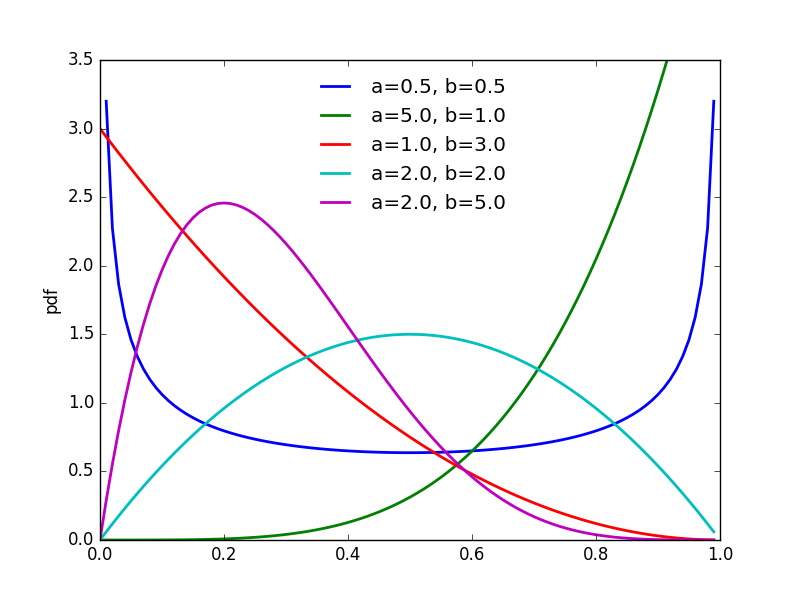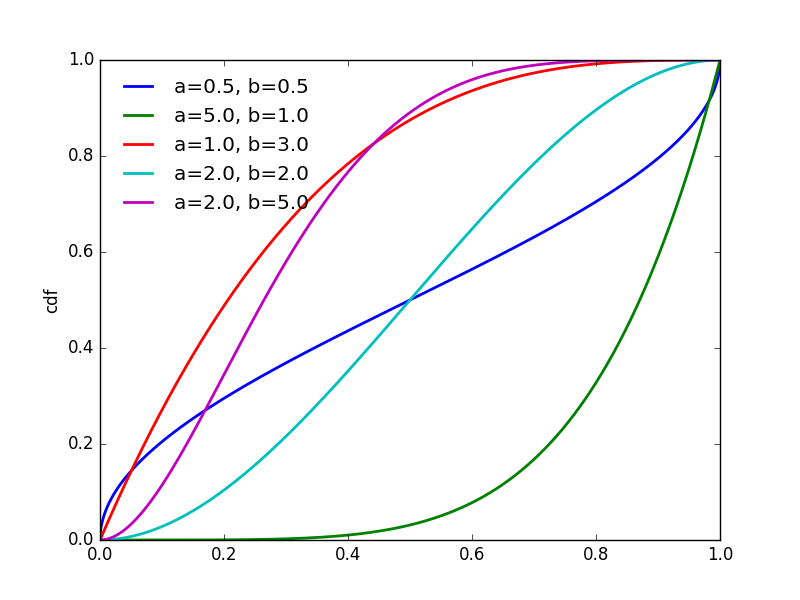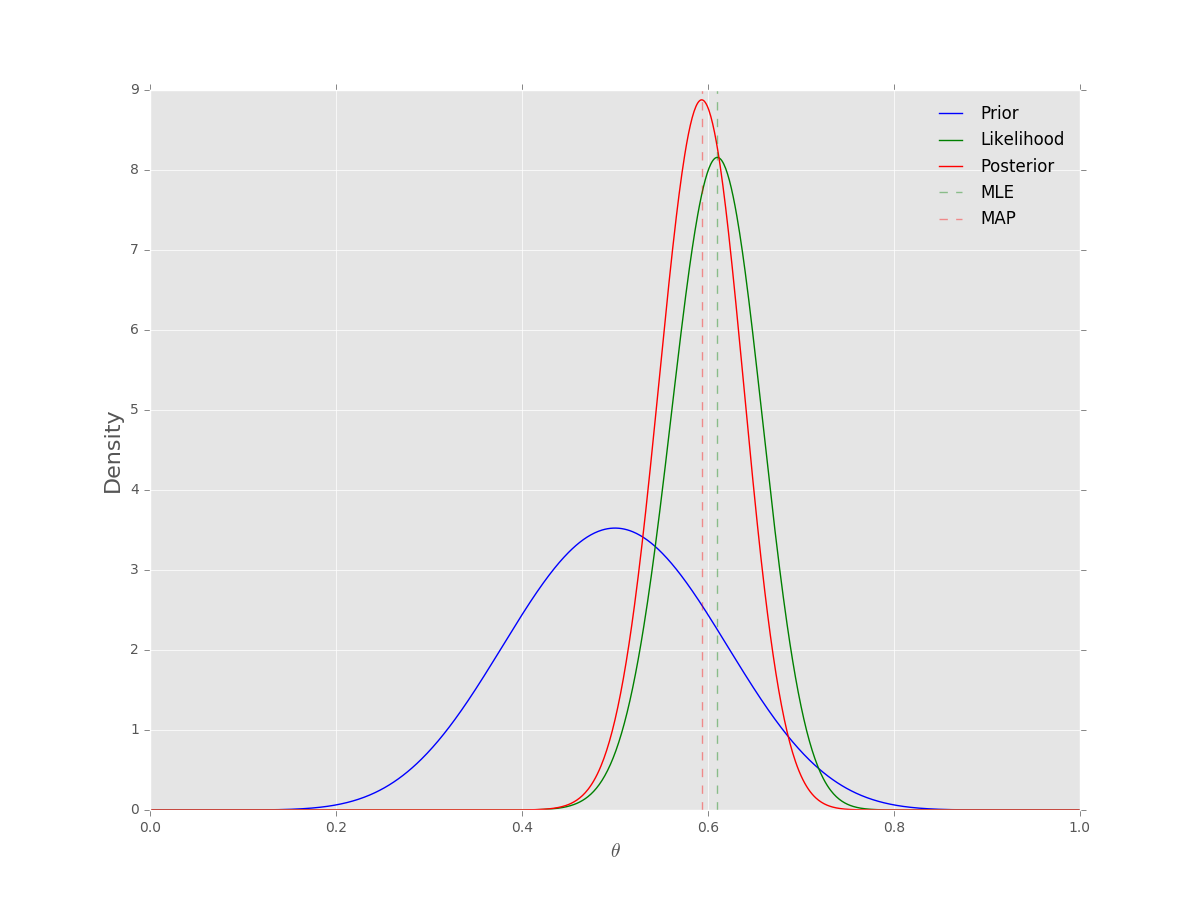相关函数在scipy.special
import scipy.special as ss
ss.beta(x1, x2)
相关分布(概率密度)在scipy.stats
import scipy.stats as st
ss.beta(a, b) # 随机变量
β
Function:
B(x,y)=∫10tx−1(1−t)y−1dt
主要性质:
B(x,y)=B(y,x)B(x,y)=(x−1)!(y−1)!(x+y−1)!
Γ
function
Γ(x)=∫∞0tx−1e−tdt
其递归形式如下:
Γ(x+1)=xΓ(x)
关系
B(x,y)=Γ(x)Γ(y)Γ(x+y)
scipy中的相关实现
>>> from scipy.special import beta
>>> from scipy.special import gamma
>>> beta(6, 7) == gamma(6)*gamma(7)/gamma(6+7)
True
Beta distribution 及其与Beta function and Gamma function的关系
Beta分布的概率密度函数(pdf)为:
f(x;α,β)===C⋅xα−1(1−x)β−1Γ(x+y)Γ(x)Γ(y)xα−1(1−x)β−11Beta(x,y)xα−1(1−x)β−1
f(x;2,2)=x(1−x)Beta(2,2)
>>> st.beta(2, 2).pdf(.5) == .5*.5/ss.beta(2, 2)
True
beta distribution是一种在[0, 1]区间上的连续分布,在[0, 1]区间内概率密度值可以为
∞
,再次证明了概率密度函数值不是密度。
import numpy as np
import scipy.special as ss
from scipy import integrate
import matplotlib.pyplot as plt
def beta(x, a, b):
return x**(a-1)*(1-x)**(b-1)/ss.beta(a, b)
def show_pdf():
x = np.arange(0, 1, .01)
for (a, b) in [(.5, .5), (5, 1), (1, 3), (2, 2), (2, 5)]:
plt.plot(x, beta_pdf(x, a, b), label='a={:.1f}, b={:.1f}'.format(a, b), lw=2)
plt.legend(loc='upper center', frameon=False)
plt.ylim([0, 3.5])
plt.ylabel('pdf')
plt.savefig('./imgs/pdf.png')
plt.show()
def show_cdf():
x = np.arange(0+0.0001, 1, .0001)
for (a, b) in [(.5, .5), (5, 1), (1, 3), (2, 2), (2, 5)]:
plt.plot(x, [(integrate.quad(beta_pdf, 0, x, args=(a, b)))[0] for x in x],
label='a={:.1f}, b={:.1f}'.format(a, b), lw=2)
plt.legend(loc='upper left', frameon=False)
plt.ylabel('cdf')
plt.savefig('./imgs/cdf.png')
plt.show()
if __name__ == '__main__':
show_pdf()
show_cdf()
- 1
- 2
- 3
- 4
- 5
- 6
- 7
- 8
- 9
- 10
- 11
- 12
- 13
- 14
- 15
- 16
- 17
- 18
- 19
- 20
- 21
- 22
- 23
- 24
- 25
- 26
- 27
- 28
- 29
- 30
- 31
- 1
- 2
- 3
- 4
- 5
- 6
- 7
- 8
- 9
- 10
- 11
- 12
- 13
- 14
- 15
- 16
- 17
- 18
- 19
- 20
- 21
- 22
- 23
- 24
- 25
- 26
- 27
- 28
- 29
- 30
- 31


Beta分布的峰值在
a−1a+b−2
处取得,这一点在概率密度函数的曲线中可清晰地看出。
先验为
Beta
分布,似然为二项分布时的后验分布
p(θ)=θa−1(1−θ)b−1B(a,b)p(X|θ)=(nk)θk(1−θ)n−kp(θ|X)=θa+k−1(1−θ)b+n−k−1B(a+k,b+n−k)
import numpy as np
import scipy.stats as st
import matplotlib.pyplot as plt
n, k = 100, 61
p = k/n
rv = st.binom(n, p)
a, b = 10, 10
prior = st.beta(a, b)
poster = st.beta(a+k, b+n-k)
thetas = np.arange(0, 1, .001)
plt.figure(figsize=(12, 9))
plt.style.use('ggplot')
plt.plot(thetas, prior.pdf(thetas), 'b', label='Prior')
plt.plot(thetas, n*st.binom(n, thetas).pmf(k), 'g', label='Likelihood')
plt.plot(thetas, poster.pdf(thetas), 'r', label='Poster')
plt.axvline(p, c='g', ls='--', label='MLE', alpha=.4)
plt.axvline((a+k-1)/(a+b+n-2), c='r', ls='--', label='MAP', alpha=.4)
plt.legend(frameon=False)
plt.xlabel(r'$\theta$', fontsize=14)
plt.ylabel('Density', fontsize=16)
plt.show()
- 1
- 2
- 3
- 4
- 5
- 6
- 7
- 8
- 9
- 10
- 11
- 12
- 13
- 14
- 15
- 16
- 17
- 18
- 19
- 20
- 21
- 22
- 23
- 24
- 25
- 1
- 2
- 3
- 4
- 5
- 6
- 7
- 8
- 9
- 10
- 11
- 12
- 13
- 14
- 15
- 16
- 17
- 18
- 19
- 20
- 21
- 22
- 23
- 24
- 25












 本文详细介绍了Beta函数和Beta分布的基本概念与应用。探讨了Beta函数的定义、性质及与Gamma函数的关系,并通过实例展示了如何使用scipy进行计算。同时,深入分析了Beta分布的概率密度函数、与Beta函数的关系以及在贝叶斯统计中的应用。
本文详细介绍了Beta函数和Beta分布的基本概念与应用。探讨了Beta函数的定义、性质及与Gamma函数的关系,并通过实例展示了如何使用scipy进行计算。同时,深入分析了Beta分布的概率密度函数、与Beta函数的关系以及在贝叶斯统计中的应用。
















 3万+
3万+

 被折叠的 条评论
为什么被折叠?
被折叠的 条评论
为什么被折叠?








